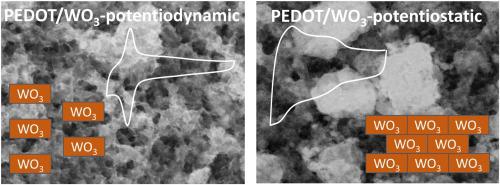当前位置:
X-MOL 学术
›
Synth. Met.
›
论文详情
Our official English website, www.x-mol.net, welcomes your
feedback! (Note: you will need to create a separate account there.)
Insights on the electrodeposition mechanism of tungsten oxide into conducting polymers: Potentiostatic vs. potentiodynamic deposition
Synthetic Metals ( IF 4.0 ) Pub Date : 2020-09-01 , DOI: 10.1016/j.synthmet.2020.116469 D.V. Zhuzhelskii , E.G. Tolstopjatova , A.I. Volkov , S.N. Eliseeva , G.G. Láng , V.V. Kondratiev
Synthetic Metals ( IF 4.0 ) Pub Date : 2020-09-01 , DOI: 10.1016/j.synthmet.2020.116469 D.V. Zhuzhelskii , E.G. Tolstopjatova , A.I. Volkov , S.N. Eliseeva , G.G. Láng , V.V. Kondratiev

|
Abstract In this work we have investigated the electrochemical deposition of tungsten oxide into different conducting polymer films from the metastable acidic solution of isopolytungstate. Two different in the nature conducting polymer (CP) materials, namely, poly-3,4-ethylenedioxythiophene (PEDOT) and poly-3,4-ethylenedioxypyrrole (PEDOP) were used as electrode substrates for electrodeposition. Electrodeposition of tungsten oxide into freshly prepared conducting polymer films was performed by two electrochemical methods: potentiostatic and potentiodynamic. The electrochemical behavior of CP/WO3 composites, obtained with variation of synthesis conditions, was investigated by cyclic voltammetry in 0.5 M sulfuric acid. The comparison of electrochemical properties of composites allows to conclude on the mechanism of WO3 deposition. It was shown that precipitates of WO3 in CPs, electrodeposited by potentiodynamic method, display very symmetrical and sharp peaks of the redox transformation of WO3, which are rarely reported for tungsten oxides. The effect of electrochemical deposition method on the growth of WO3 precipitates on conducting polymer film electrodes and the electrochemical properties of composites was also investigated by combined cyclic voltammetry and electrochemical quartz crystal microbalance (EQCM). The role of polyoxotungstate anion species trapping in CPs during p-doping process and facile formation of tungsten oxide nanostructures in CPs matrix is considered. A mechanism for the electrodeposition of tungsten oxide into PEDOT and PEDOP polymers was proposed.
中文翻译:

关于氧化钨在导电聚合物中的电沉积机制的见解:恒电位与动电位沉积
摘要 在这项工作中,我们研究了氧化钨从异多钨酸盐的亚稳态酸性溶液电化学沉积到不同导电聚合物薄膜中的过程。两种性质不同的导电聚合物(CP)材料,即聚-3,4-乙撑二氧噻吩(PEDOT)和聚-3,4-乙撑二氧吡咯(PEDOP)被用作电沉积的电极基材。通过两种电化学方法将氧化钨电沉积到新制备的导电聚合物薄膜中:恒电位和动态电位。在 0.5 M 硫酸中通过循环伏安法研究了随合成条件变化而获得的 CP/WO3 复合材料的电化学行为。复合材料电化学性能的比较可以得出关于 WO3 沉积机制的结论。结果表明,通过动电位法电沉积的 CPs 中 WO3 的沉淀物显示出非常对称和尖锐的 WO3 氧化还原转化峰,这在氧化钨中很少见。还通过循环伏安法和电化学石英晶体微天平(EQCM)的组合研究了电化学沉积方法对 WO3 沉淀物在导电聚合物膜电极上生长的影响以及复合材料的电化学性能。考虑了多氧钨酸阴离子物质在 p 掺杂过程中捕获在 CPs 中的作用以及在 CPs 基质中容易形成氧化钨纳米结构。提出了一种将氧化钨电沉积到 PEDOT 和 PEDOP 聚合物中的机制。显示出 WO3 氧化还原转化的非常对称和尖锐的峰,这在氧化钨中很少报道。还通过循环伏安法和电化学石英晶体微天平(EQCM)的组合研究了电化学沉积方法对 WO3 沉淀物在导电聚合物膜电极上生长的影响以及复合材料的电化学性能。考虑了多氧钨酸阴离子物质在 p 掺杂过程中捕获在 CPs 中的作用以及在 CPs 基质中容易形成氧化钨纳米结构。提出了一种将氧化钨电沉积到 PEDOT 和 PEDOP 聚合物中的机制。显示出 WO3 氧化还原转化的非常对称和尖锐的峰,这在氧化钨中很少报道。还通过循环伏安法和电化学石英晶体微天平(EQCM)的组合研究了电化学沉积方法对 WO3 沉淀物在导电聚合物膜电极上生长的影响以及复合材料的电化学性能。考虑了多氧钨酸阴离子物质在 p 掺杂过程中捕获在 CPs 中的作用以及在 CPs 基质中容易形成氧化钨纳米结构。提出了一种将氧化钨电沉积到 PEDOT 和 PEDOP 聚合物中的机制。还通过循环伏安法和电化学石英晶体微天平(EQCM)的组合研究了电化学沉积方法对 WO3 沉淀物在导电聚合物膜电极上生长的影响以及复合材料的电化学性能。考虑了多氧钨酸阴离子物质在 p 掺杂过程中捕获在 CPs 中的作用以及在 CPs 基质中容易形成氧化钨纳米结构。提出了一种将氧化钨电沉积到 PEDOT 和 PEDOP 聚合物中的机制。还通过循环伏安法和电化学石英晶体微天平(EQCM)的组合研究了电化学沉积方法对 WO3 沉淀物在导电聚合物膜电极上生长的影响以及复合材料的电化学性能。考虑了多氧钨酸阴离子物质在 p 掺杂过程中捕获在 CPs 中的作用以及在 CPs 基质中容易形成氧化钨纳米结构。提出了一种将氧化钨电沉积到 PEDOT 和 PEDOP 聚合物中的机制。考虑了多氧钨酸阴离子物质在 p 掺杂过程中捕获在 CPs 中的作用以及在 CPs 基质中容易形成氧化钨纳米结构。提出了一种将氧化钨电沉积到 PEDOT 和 PEDOP 聚合物中的机制。考虑了多氧钨酸阴离子物质在 p 掺杂过程中捕获在 CPs 中的作用以及在 CPs 基质中容易形成氧化钨纳米结构。提出了一种将氧化钨电沉积到 PEDOT 和 PEDOP 聚合物中的机制。
更新日期:2020-09-01
中文翻译:

关于氧化钨在导电聚合物中的电沉积机制的见解:恒电位与动电位沉积
摘要 在这项工作中,我们研究了氧化钨从异多钨酸盐的亚稳态酸性溶液电化学沉积到不同导电聚合物薄膜中的过程。两种性质不同的导电聚合物(CP)材料,即聚-3,4-乙撑二氧噻吩(PEDOT)和聚-3,4-乙撑二氧吡咯(PEDOP)被用作电沉积的电极基材。通过两种电化学方法将氧化钨电沉积到新制备的导电聚合物薄膜中:恒电位和动态电位。在 0.5 M 硫酸中通过循环伏安法研究了随合成条件变化而获得的 CP/WO3 复合材料的电化学行为。复合材料电化学性能的比较可以得出关于 WO3 沉积机制的结论。结果表明,通过动电位法电沉积的 CPs 中 WO3 的沉淀物显示出非常对称和尖锐的 WO3 氧化还原转化峰,这在氧化钨中很少见。还通过循环伏安法和电化学石英晶体微天平(EQCM)的组合研究了电化学沉积方法对 WO3 沉淀物在导电聚合物膜电极上生长的影响以及复合材料的电化学性能。考虑了多氧钨酸阴离子物质在 p 掺杂过程中捕获在 CPs 中的作用以及在 CPs 基质中容易形成氧化钨纳米结构。提出了一种将氧化钨电沉积到 PEDOT 和 PEDOP 聚合物中的机制。显示出 WO3 氧化还原转化的非常对称和尖锐的峰,这在氧化钨中很少报道。还通过循环伏安法和电化学石英晶体微天平(EQCM)的组合研究了电化学沉积方法对 WO3 沉淀物在导电聚合物膜电极上生长的影响以及复合材料的电化学性能。考虑了多氧钨酸阴离子物质在 p 掺杂过程中捕获在 CPs 中的作用以及在 CPs 基质中容易形成氧化钨纳米结构。提出了一种将氧化钨电沉积到 PEDOT 和 PEDOP 聚合物中的机制。显示出 WO3 氧化还原转化的非常对称和尖锐的峰,这在氧化钨中很少报道。还通过循环伏安法和电化学石英晶体微天平(EQCM)的组合研究了电化学沉积方法对 WO3 沉淀物在导电聚合物膜电极上生长的影响以及复合材料的电化学性能。考虑了多氧钨酸阴离子物质在 p 掺杂过程中捕获在 CPs 中的作用以及在 CPs 基质中容易形成氧化钨纳米结构。提出了一种将氧化钨电沉积到 PEDOT 和 PEDOP 聚合物中的机制。还通过循环伏安法和电化学石英晶体微天平(EQCM)的组合研究了电化学沉积方法对 WO3 沉淀物在导电聚合物膜电极上生长的影响以及复合材料的电化学性能。考虑了多氧钨酸阴离子物质在 p 掺杂过程中捕获在 CPs 中的作用以及在 CPs 基质中容易形成氧化钨纳米结构。提出了一种将氧化钨电沉积到 PEDOT 和 PEDOP 聚合物中的机制。还通过循环伏安法和电化学石英晶体微天平(EQCM)的组合研究了电化学沉积方法对 WO3 沉淀物在导电聚合物膜电极上生长的影响以及复合材料的电化学性能。考虑了多氧钨酸阴离子物质在 p 掺杂过程中捕获在 CPs 中的作用以及在 CPs 基质中容易形成氧化钨纳米结构。提出了一种将氧化钨电沉积到 PEDOT 和 PEDOP 聚合物中的机制。考虑了多氧钨酸阴离子物质在 p 掺杂过程中捕获在 CPs 中的作用以及在 CPs 基质中容易形成氧化钨纳米结构。提出了一种将氧化钨电沉积到 PEDOT 和 PEDOP 聚合物中的机制。考虑了多氧钨酸阴离子物质在 p 掺杂过程中捕获在 CPs 中的作用以及在 CPs 基质中容易形成氧化钨纳米结构。提出了一种将氧化钨电沉积到 PEDOT 和 PEDOP 聚合物中的机制。











































 京公网安备 11010802027423号
京公网安备 11010802027423号